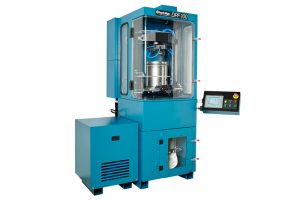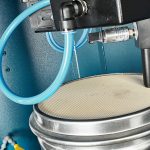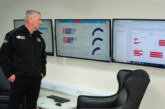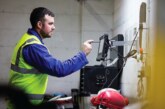With Euro 6 regulations, trucks and bus emissions have never been less toxic. But how do you prevent trapped soot and ash causing health issues in the workshop? It’s time to rethink DPF servicing, says Hartridge.
Over the past decade or so ever-tightening EU regulations have seen harmful emissions from trucks and buses fall dramatically. Nitrous Oxide (NOx) and Particulate Matter (PM) have been the main targets because of their carcinogenic properties and the impact on health and overall urban air quality.
Most emissions control has been achieved with exhaust after-treatment systems – Selective Catalyst Reduction technology to control NOx emissions and Diesel Particulate Filters (DPFs) to trap the PM (particulate matter, or soot) in the exhaust gas stream. SCR relies on the addition of AdBlue catalyst to convert the Nitrous Oxide, while DPFs incorporate active and passive regeneration systems to oxidise accumulated carbon deposits, preventing the filter getting blocked.
The workshop problem
However, while this technology is playing a crucial role in improving air quality with truck and bus emissions at an all-time low, little has been reported about the health and safety risks associated with handling urea (a pure form of ammonia) in the workshop, or from servicing DPFs.
Its experience in the US has given Hartridge an insight into the potential problems with DPFs. Passive and active regeneration systems oxidise PM particles trapped in the filter to prevent blockages, but leave an ash residue. This builds up after time and eventually the DPF will have to be removed for clearing and there are some serious potential health and safety considerations for the workshop prior to choosing a method or process to implement.
When DPFs require servicing, the typical approach has been to remove it and send it away for cleaning, or swap it for a service-exchange unit. Either way, there is unplanned downtime and expense. Unlike in the USA, on-premises cleaning is not widely established in the UK, because DPF filters are only just reaching that stage in their lives where enough ash has accumulated to cause DPF issues.
There’s another consideration driving off-premises DPF cleaning – workshop health and safety. Blocked filters will contain some carcinogenic particulate matter and ash. The post-combustion ash is present in very fine particles that remain airborne for some time and should not be inhaled. So while it can be tempting to try a quick-fix by simply blowing the ash out with a compressed air line, you would be in breach of Health and Safety regulations as well as risking damage to the DPF core.
Same-day cleaning
Vehicle manufacturers typically recommend DPF maintenance on mileage intervals or annually, but US experience has taught us that prevention is better than cure: proactively plan your DPF maintenance as part of routine servicing rather than react once vehicle performance has become a problem.
Hartridge is advocating a new approach: cleaning the DPF on the same day the vehicle is in for service. Operators should treat ash and soot build-up as important a service requirement as changing oil and filter changes are, says the company.
For this to be practical, the DPF cleaning machine has to be installed at or close to the workshop to be of any use for achieving a same day service, and it has to deal with the issue of air contamination that cleaning processes can initiate.
The DPF cleaning method itself has to be fast and easy to do so that it does not extend vehicle downtime beyond that scheduled slot. It needs to be automated so technicians are not diverted from other service tasks.
From a health and safety view it is important that any method or machine used to clean DPF’s protects the workshop employees from coming in to contact with the carcinogenic soot and ash. The Hartridge machine itself creates a vacuum in the cleaning chamber sucking the soot and ash in to a special bag that can be sealed, removed and then responsibly disposed of in line with hazardous waste regulations.
Also, the Hartridge machine is correctly zoned for ATEX, the European directive for controlling explosive atmospheres. This means that special components and non-static materials have been used to ensure that the potential for the soot and ash to ignite and explode is removed from the equation.









